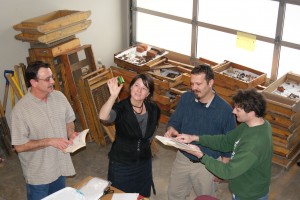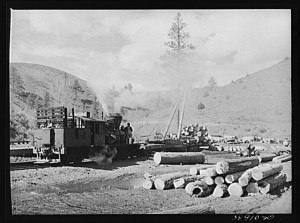Above ground, below ground, on the ground: CRM in practice
03 March 2015 – Natalie Perrin
The Public Historian, historic preservation, National Historic Preservation Act commemoration, archaeology, cultural resource management
Editor’s note: This post continues a series commemorating the anniversary of the National Historic Preservation Act by examining a past article published in The Public Historian, describing its significance, and relating it to contemporary conversations in historic preservation.
Locations speak to multiple generations, cultures, and time periods. “Appreciating the complexity of the historic period,” according to Ted Karamanski in “Logging, History, and the National Forests: A Case Study of Cultural Resource Management” (The Public Historian, 1985), is at the forefront of cultural resource management (CRM), no matter when or where you practice (30). But knowing which sources can reveal the layers of multiple historic contexts can be challenging, both in the field and in the library.

Michael Faulkner, Natalie Perrin, Brad Bowden, and Chris Knutson of HRA Portland collaborate on an archaeological find. Together, the team was able to pinpoint the date range of the find and trace it to an original homestead. Photo credit: Natalie Perrin
The layering of generations was at the crux of the challenges that Karamanski outlined in 1985 and that I face in my own career today. Although I’m formally trained in historic preservation and architectural history, over the past six years at Historical Research Associates, my duties have morphed to include managing archaeological investigations. I’ve learned the “archy speak” fluently enough to navigate the appropriate laws, and I am on a first name basis with a few state archaeologists. The adventure, however, has also brought me to the same conclusion Karamanski arrived at in his article: “both archaeologists and historians are necessary, and their work must be integrated” (39). In many ways, not much seems to have changed in the regulatory environment, though the definition of “cultural resource” seems to be expanding every day.
In Karamanski’s day, for example, “no one ever seriously considered managing . . . former timber extraction sites as historical resources” (28). I practice CRM in the Pacific Northwest, however, and logging and the company towns associated with the timber industry are my bread and butter. Our more pertinent question is whether a site is merely old or actually significant. For that, you need to know your history, which requires excellent field investigators from multiple disciplines.
Archaeologists and architectural historians are both trained in the research methods needed to develop a thorough historic context, although each utilizes different yet equally important sources. Without considering the comprehensive research that historians can provide, archaeologists, for example, might not be aware of appropriate locations for survey. Archaeologists consider the flora, fauna, soils, and historic land-use patterns and bring exacting investigative techniques to the table. Preservationists and architectural historians provide the maps, historic photos, and general knowledge of construction techniques that inform understanding of discoveries in the field. Allowing any one discipline–be it archaeology, history, or historic preservation–to predominate in your investigations is a sure way to miss something in the field.
In a recent survey in Central Oregon, the historians uncovered information relating to the settlement patterns of a specific cultural group, single women who flocked to the high deserts of Oregon in part due to the Enlarged Homestead Act of 1909. Women settlers, along with others, built simple but typical features on their homesteads: small, wood-frame cabins and sheds, a privy, a hand-dug well, and the occasional windmill. The period of prosperity of the high desert was short, and by 1920 the boom was bust. The rural nature of the project area meant that few, if any, historic maps would mark locations of such activities, but the knowledge at least gave both archaeologists, who tend to look down, and architectural historians/historic preservationists, who tend to look up, an idea of what resources might be encountered in the field. When combined, it created a trifecta of knowledge and expertise, a CRM Voltron, if you will.
Site testing was, and continues to be, an essential component of CRM investigation. Provisions for presenting the results of these investigations for future researchers, however, can be a challenge. I speak specifically of inventories, usually managed by the State Historic Preservation Office (SHPO). In the thirty years since Karamanski described his experiences, some inventory systems are still skewed toward archaeology, while others rely on individual buildings with numbered addresses. Both of these create challenges in documenting resources that don’t neatly fit the mold, including linear features, such as transmission lines and canals; cultural landscapes that include multiple layers of human occupation, both historic and prehistoric; and those resources that straddle the line between archaeological and historic, such as abandoned railways, paved-over streetcar tracks, and aging utility systems. Though the National Park Service created the National Register Criteria for Evaluation in 1990, an excellent set of parameters within which to evaluate our cultural resources, it seems most states and federal agencies are still struggling with applying these parameters to the inventories of the ever-growing number of cultural resources being recorded throughout the country.

Today, the remnants of logging camps, like this one photographed in Oregon in 1941, require multifaceted historical investigation. Photo credit: Library of Congress
Lack of both uniformity and flexibility in inventory methods, forms, and databases present problems to those who record resources. Was the abandoned logging community recorded as a building, structure, historic district, or archaeological site? In what level of detail was the site recorded? Is the recordation focused primarily on archaeology, in which case there may be an in-depth description of debitage (waste material found at sites where stone weapons were made) but no comment on extant built resources? Or did an architectural historian record in exacting detail the cladding and windows on a creek-side cabin but fail to see evidence of 4,000 years of occupation in the form of a lithic scatter? Is the prehistoric and historic context accurate, thorough, well researched, and properly cited, or was it based on a single secondary source? Alternately, is there a context at all?
In short, the best cultural resource investigations include the right staff and enough time and budget to do the job. Someone needs to look at the documents, maps, photos, and history books; someone needs to look at the ground; and someone needs to look at the landscape. This hasn’t changed in the past thirty years, and if anything, we’ve come a long way in having the various disciplines work together. Karamanski’s case study called for historians to change federal policy to place more importance on history in CRM. This change seems to be happening, both organically and as part of revised federal policies. The Secretary of the Interior has adopted Professional Qualification Standards for history, archaeology, and architectural history, all of which emphasize the importance of research. And while the below-ground and above-ground folks still like to pretend that their paths do not, should not, or cannot cross, Karamanski said it best: “Historic resource management is an interdisciplinary pursuit, requiring the cooperation of historians and historical architects as well as archaeologists” (29). Amen!
~ Natalie Perrin is an Architectural Historian and Historic Preservation Specialist at Historical Research Associates, Inc., in Portland, Oregon. When not crawling through historic buildings, she enjoys paddling outrigger canoes and relaxing with the family.



